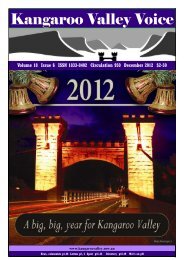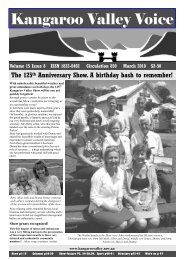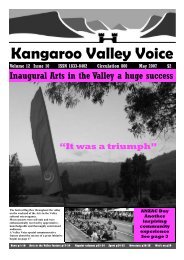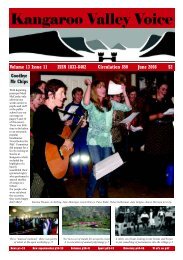Copy of May 2011 - Lazyfish Technology
Copy of May 2011 - Lazyfish Technology
Copy of May 2011 - Lazyfish Technology
Create successful ePaper yourself
Turn your PDF publications into a flip-book with our unique Google optimized e-Paper software.
<strong>May</strong> <strong>2011</strong> Kangaroo Valley Voice www.kangaroovalley.nsw.au Page 37<br />
Special ANZAC memories<br />
(Continued from page 3)<br />
over and sank on 30 June. She was the first<br />
RAN loss from enemy action in World War II,<br />
but the fourth loss from the 10th Destroyer<br />
Flotilla. HMS Defender survived Waterhen by<br />
only a few days. On 11 July she too was<br />
bombed and sunk during her return run to<br />
Alexandria in company with HMAS Vendetta.<br />
The crew <strong>of</strong> HMAS<br />
Waterhen getting ready<br />
to abandon the sinking<br />
ship<br />
During the campaigns in<br />
Greece and<br />
Crete Waterhen (I) had<br />
escorted convoys on<br />
several occasions. When<br />
the Greek campaign was<br />
finally seen to be a lost<br />
cause, she played her<br />
Harry Eagle (1941) part in evacuating the<br />
Allied troops by embarking seventy men at<br />
Megara, Greece, on 26 April 1941 and<br />
disembarking them at Suda Bay.<br />
The following month she assisted in the<br />
evacuation <strong>of</strong> Crete.<br />
In <strong>May</strong> 1941 the regular 'Tobruk Ferry Service'<br />
for the supply and reinforcement <strong>of</strong> the<br />
beleaguered Australian garrison at Tobruk was<br />
instituted by destroyers <strong>of</strong> the Inshore Squadron.<br />
This duty occupied Waterhen (I) for the<br />
remainder <strong>of</strong> her career.<br />
On 28 June 1941 Waterhen (I) left Alexandria<br />
for Tobruk with Defender on what was to be her<br />
last run. At 7:45 pm on the 29th, <strong>of</strong>f Sollum,<br />
both ships were attacked by dive bombers<br />
and Waterhen (I), though not directly hit, was<br />
holed by near misses and immobilized. Her<br />
ship's company and embarked troops were taken<br />
<strong>of</strong>f by Defender. There were no casualties.<br />
As darkness fell, Defender took Waterhen (I) in<br />
tow, but it was soon apparent that she could not<br />
be saved and the working party was taken <strong>of</strong>f.<br />
At 1:50 am on 30 June 1941 the twenty-three<br />
year old 'Chook', as she was affectionately<br />
known to her crew, rolled over and sank.<br />
She was the first ship <strong>of</strong> the RAN to be lost by<br />
enemy action in World War II.<br />
After the war he married Rona in 1947 and<br />
fathered eight children, worked as an owner<br />
driver on interstate trucking and lost his life<br />
aged 35 when his semi trailer overturned at<br />
Gundagai NSW in December 1957.<br />
Phillip’s father Andrew George Scott was born<br />
12/9/1916 enlisted in the A.I.F. 12/5/41 2/4<br />
Australian Pioneer Battalion.<br />
Demobbed 28/11/45<br />
Originally despatched to fight in Singapore but<br />
on the way there<br />
Singapore fell so<br />
they were sent to<br />
defend Darwin<br />
and ended up<br />
staying for the<br />
duration. He also<br />
spent time at Pine<br />
Creek in N.T.<br />
The 2/4th Pioneer<br />
Battalion was<br />
raised at Greta<br />
army camp in<br />
February 1941. “Paddy” Scott (1939)<br />
After initial training, it arrived in Darwin in<br />
September 1941 and established headquarters<br />
at Noonamah.<br />
Its companies worked on defensive positions<br />
between Adelaide River and Darwin.<br />
On 14 February 1942 the battalion left Darwin<br />
and sailed with the “Sparrow Force” to Timor.<br />
Japanese aircraft bombing forced them to<br />
return following the Fall <strong>of</strong> Singapore.<br />
The ship arrived in Darwin Harbour on 18<br />
February and was sunk by the Japanese during<br />
the attack on the harbour the next day.<br />
The battalion’s equipment went down with it.<br />
The 2/4th spent the next 13 months defending<br />
various locations in the Darwin area, until they<br />
were finally relieved in March 1943. After<br />
some leave the pioneers regrouped for jungle<br />
training on the Atherton Tablelands.<br />
However, the war was nearly when the<br />
battalion went overseas to support the 9th<br />
Division landing in Borneo.<br />
The OBOE operations aimed to reoccupy areas<br />
(Continued on page 44)<br />
FOR ALL YOUR EARTHMOVING REQUIREMENTS<br />
Dozers<br />
Graders<br />
Excavator<br />
Trucks<br />
Rural roads<br />
House/Shed<br />
sites<br />
Clearing<br />
Horse arenas<br />
Dam design &<br />
construction<br />
Decorative<br />
Rock work<br />
44 651 177<br />
Ge<strong>of</strong>f & Tania Sharman<br />
Ge<strong>of</strong>f 0409 289 122 Tania 0409 289 123

















